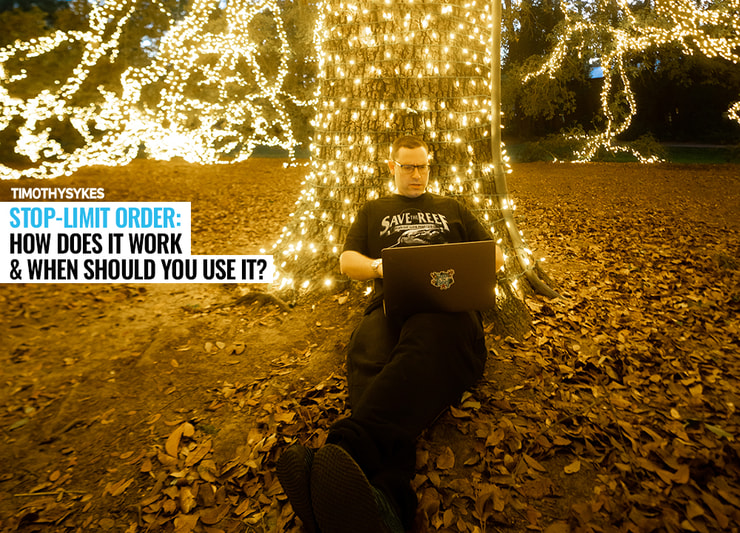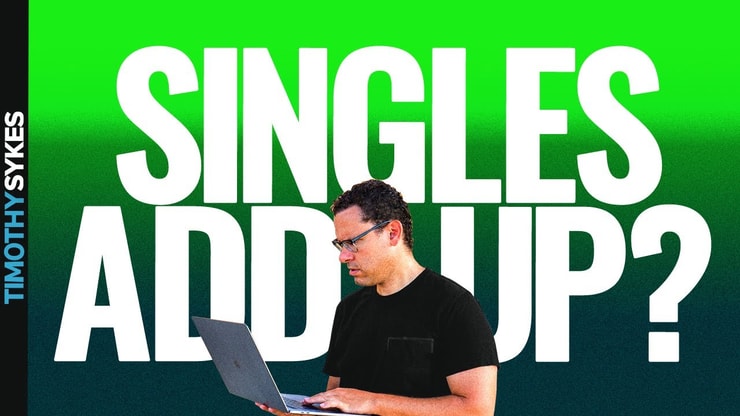Stop-limit order. What is it? Is it the same as a stop loss?
A stop-limit order is a type of stop-loss order. They’re both ways to automatically execute sell orders. There’s also a type of order called a buy limit order. You can use it to buy shares. There are so many different types of orders…
The list goes on and on. It can get confusing.
So, in this post, I’m going to clarify what a stop-limit order is, how and when you should use it, and some of the risks of stop limits.
Read on…
Table of Contents
- 1 What’s a Stop Limit Order?
- 2 How Does a Stop-Limit Order Work?
- 3 What’s the Difference Between a Stop-Loss and Stop-Limit Order?
- 4 Limit Order vs. Stop Order: What’s the Difference?
- 5 Understanding Stop-Limit Orders With a Practical Example
- 6 Should You Use Stop-Limit Orders?
- 7 3 Top Stop-Limit Order Strategies
- 8 How to Set a Trailing Stop-Limit Order
- 9 What Are the Risks of a Stop-Limit Order?
- 10 When to Use Stop-Limit Orders
- 11 Frequently Asked Questions About Stop-Limit Orders
- 12 Conclusion
What’s a Stop Limit Order?
A stop-limit order is a type of stop-loss order. You can set it to automatically sell your position when a stock reaches your stop price. It’s a way to specify the exact amount at which you’re willing to sell your position.
Traders use stop-limit orders to protect their accounts from large losses.
New to penny stocks? Start with my FREE online guide here.
How Does a Stop-Limit Order Work?

2025 Millionaire Media, LLCA stop-limit order is like a stop-loss order, but with a limit price. When the stop price in your order is triggered, your position will sell at your limit price or better. A stop-limit order won’t kick in below the limit price you’ve specified.
When setting up a stop-limit order, you’ll have to enter three conditions:
- The stop price that will trigger your order.
- Your limit price — the price at which you’re willing to sell or buy.
- A time frame for your order.
Your stop price and limit price can be the same. Or your stop price can be set to trigger the order a bit before your limit price. Your limit price is the absolute lowest you’d want to sell for.
But if a stock drops too quickly for a sale to be executed at your limit price, you’ll still be in the position. Your order also won’t be executed if the stock gaps down overnight. Because stop-limit orders don’t execute after hours.
Want to make better sense of the markets? Start with my 30-Day Bootcamp. In just 30 days, you can start building a trading knowledge foundation that can serve you for years to come. Get in the Bootcamp NOW.
Buy Stop-Limit Order
You can use a buy stop-limit order if you’re in a short position. It’s like a stop loss for short sellers. Your buy-to-cover order will execute once the buy stop price is triggered.
You can also use a buy stop-limit order to purchase shares. It could work with a setup like a breakout. If you’re anticipating a breakout, set your buy stop-limit order just above the breakout level. You could take advantage of a price rise.
Read more about trading breakouts here.
Sell Stop-Limit Order
Traders use sell stop limits to protect traders against huge losses. You can set your stop price at your risk level on a chart or your maximum dollar loss level. This will close out your position before your losses get too big.
You can use a sell stop-limit order to sell your long position for a small loss. Or you can use it to enter a short position if a stock breaks down below a support level.
What’s the Difference Between a Stop-Loss and Stop-Limit Order?
With a stop-loss order, you only enter one price — the price where you want your sell order to be triggered. Then the order becomes a market order and could execute at a lower price. But you know for sure your order will be executed.
With a stop-limit order, you enter two prices: your stop price and a limit price. Your order will be triggered at your stop price but won’t execute below your limit price.
If a stock doesn’t have enough liquidity or if it’s too volatile, your order might not be executed. More on how volatility affects stop-limit orders later on…
Limit Order vs. Stop Order: What’s the Difference?

2025 Millionaire Media, LLCA limit order isn’t a type of stop-loss order. And it’s not an automatic order. You have to enter it manually when you want to buy or sell a stock. A limit order is all I use to buy or sell stocks. I never use a market order or stop losses.
A limit order specifies how much you’re willing to pay for a stock or how much you want to sell it for. Your order will only be executed at your limit price or better.
If a stock is volatile and moving fast, I’ll set my buy limit price a couple of cents above the current price, to make sure I get executed and get a position. And when I’m cutting a losing trade, I enter a price a few cents below the market price. I want to be sure I can get out of a losing trade.
A stop order is an order you enter before you’re ready to buy or sell. You’re setting up an order for a future price, either to buy at a higher price or sell at a lower price.
With a stop order, your order becomes a market order once it’s triggered. Unless you enter a stop-limit order with your specified limit price.
Understanding Stop-Limit Orders With a Practical Example
All the different order types and stop orders can get confusing. Let’s look at a stop-limit order with an example…
Let’s say it’s morning, and you’re watching a stock that you think has the potential to go higher during the day. So you enter on a dip, but then you have to get out the door and go to your 9-to-5 job. So you decide to set a stop-limit order in case your setup doesn’t work.
If you bought 1,000 shares on a dip at $1.05 and your maximum loss per trade is $50, you could set your stop price at $1.01 and your limit price at $1. So if the order works and gets fully executed at your limit price or better, your max loss will be $50.
In this example, a trailing stop-limit order might be a better option if you can’t watch your position all day. That way you could possibly end up with a profit. I’ll get into how trailing stops work in a bit…
Should You Use Stop-Limit Orders?
I personally don’t use stop-loss orders or stop-limit orders. I go over the reasons I don’t use them in this post.
They can be great for traders who can’t be in front of the computer all day watching their positions. You can also use them to help you cut losses if you’re undisciplined.
But if you’re having trouble with discipline, try paper trading on StocksToTrade. (I’m a proud investor in StocksToTrade and helped develop it to fit the low-priced stocks I love to trade.) Save your hard-earned money for trading after you’ve mastered the rules. I outline my trading rules in this post.
And speaking of mastery…
Join me in my next Market Mastery Live Trading Webinar. When you sign up you don’t just get one day of trading with me. You get 12 days! You’ll be able to join me about once a month for live trading for a full year!
3 Top Stop-Limit Order Strategies

2025 Millionaire Media, LLCBelow are three top stop-limit order strategies you can use to improve your trading success.
More Breaking News
- Rivian’s Financial Rollercoaster: Deeper Insights
- SXTC Stock Soars: Time to Invest?
- HTZ Faces Data Breach and Restructuring Woes
Don’t Follow the Masses
The main reason I don’t use stop losses is that most traders tend to put them all in the same area. Usually around a whole or half number or around an area of support. This sounds like the right thing to do, right?
Well, if most traders lose, why would you want to do what they’re doing?
Trading isn’t an exact science. Support levels don’t hold to the exact dollar or penny. So stop losses can be triggered. And that brings the price just below the support level where buyers come in and bring the price right back up.
I prefer to watch the chart pattern and price action when I’m in a trade. If I don’t like what it’s doing, I can get out. I don’t have to wait till it’s a loss. If I don’t like the price action, I can take my single and move on.
Trade the Volatility
Volatility can affect the execution of stop-limit orders. If your position is in a very volatile stock, you might need a wider stop. Especially if the stock’s having huge price swings throughout the day. This can prevent you from getting shaken out of your position prematurely.
The more volatile a stock is, the greater the chances it can crash through your stop-limit order without being sold.
With highly volatile stocks, a stop-loss order might be the safer way to go. It could mean taking a bigger loss, because the order will become a market order once triggered. But it could save you an even bigger loss if you got stuck in a position.
For help trading in this volatile market, get my no-cost “Volatility Survival Guide.”
Use Stop Orders to Enter Positions
You wouldn’t normally think of using a buy stop order to enter a position, but you can do it. And it could give you an edge if you can’t watch the market all day.
As I explained earlier … you can use a buy stop-limit order to set a buy order ahead of a breakout and potentially take advantage of a trading opportunity.
You can also use a sell stop order to enter a short-selling position. So you could enter your sell stop order below an area of support or below the previous day’s closing price. Then you could take advantage of a green-to-red move in the stock and profit as it goes down.
I don’t recommend he started tracking everything. He figured out what was working for him. As it turns out, it was only two patterns. He’d tried short selling for new traders. It’s too risky. And it can be especially risky to be in a short position if you can’t watch it. Short squeezes can happen fast, so you have to be able to protect your account.
How to Set a Trailing Stop-Limit Order
Below are the steps to take to set a trailing stop-limit order for your position. Let’s say you already have a position in a stock and you want to limit your losses and also protect your potential profits…
Enter Your Trailing Stop-Limit Order
Once you have a position, the first step is to enter a sell order and select the “trail limit” option in the “order type” field. Then, you’ll enter the amount you’re willing to allow the stock to pull back before you want to sell.
This will depend on the volatility of the stock and its past price action. Let’s say in this example you’ll allow the stock a range of 20 cents per pullback. Then you send your order to the market. And you wait…
The Market Rises
Once the stock begins to go up, your trailing stop will follow the stock by 20 cents. You’ll stay in the position as long as it doesn’t pull back 20 cents from a recent high.
The Market Reverses
After the stock tops out, it goes down by 20 cents and hits your trailing stop-limit price, and your sell order is triggered. As long as there’s enough liquidity in the stock, your order should execute.
A trailing stop-limit order is a great way to protect your account from losses. And it allows you to take advantage of an upward trend and still lock in profits.
What Are the Risks of a Stop-Limit Order?
I’ve already touched on some of the risks of using a stop-limit order. The biggest risk is having your order unexecuted. Especially if you can’t check on your position throughout the day and make changes.
Stop-limit orders don’t protect you in after-hours trading. So if bad news is released after hours or in premarket, your order won’t execute automatically. You’ll have to be around to change it.
There’s also a risk that your order’s executed and the stock continues its upward movement. So you miss out on a great play. You have to be ready to accept the loss and move on.
If that happens, review your trade and see if there was a mistake. Maybe you used the wrong areas as support. Or maybe you did everything right and it’s just one of those things.
It’s always better to trade safely.
When to Use Stop-Limit Orders
You can use stop-loss orders when you can’t monitor your positions during the day. Use them when you’re trading volatile stocks. Or use them if you have to run out of the house while you’re in a position.
Basically, use stop-loss orders any time you can’t bring yourself to cut a loss. Either because you’re not there to do it, or if you don’t have the right trading mindset.
Remember, losses are a part of trading. If you want to be successful you have to be willing to accept losses. Even Tim Grittani, arguably the best penny stock trader of all time, only wins about 68% of the time. I win about 77% of the time.
Think you’re gonna win 100% of the time as a new trader — or ever? Not at all likely.
Frequently Asked Questions About Stop-Limit Orders
Let’s go over some frequently asked questions about stop-limit orders…
Do Stop-Limit Orders Work After Hours?
Orders placed during regular market hours that don’t get executed won’t get executed in after-hours trading. To execute an order after hours, you have to enter your order specifically as a “good till extended market”(GTEM) order.
Why Didn’t My Limit Order Execute?
If your stop-limit order price is hit after hours, your order won’t execute. Stop-limit orders won’t execute after hours. If a stock drops quickly through your stop-limit price, it might not be executed or might be only partially executed.
What’s the Activation Price on a Stop Limit?
The activation price on a stop-limit order is your stop price. It’s the price that triggers the order to be executed. This price can be the same as your stop-limit price, or it may be slightly above it.
Conclusion

2025 Millionaire Media, LLCStop-limit orders can be a good way to control losses if you can’t watch your position all day. But they aren’t guaranteed to get you out of a losing trade.
I use mental stops to exit my trades. But if you don’t have the discipline, use stop losses. Or better yet, don’t trade until you can stick to the rules. I’ve already made every mistake you could think of. That’s how I developed my trading rules.
The Trading Challenge
I teach my trading rules, patterns, and strategies in my Trading Challenge.
You don’t have to make the same mistakes I did. You can drastically speed up your learning curve if you have a mentor.
I already have six millionaire students* and many more six-figure students.* Will you be next? Apply for my Trading Challenge today and find out.
It won’t be easy. I push my students hard. I want them to have the kind of freedom that trading can offer. But you have to want it too.
If you’re on the fence about applying, don’t bother. I want students that are willing to put in the work!
Do you use stop-limit orders? Let me know in the comments … I love to hear from you!
(*Please note that these kinds of trading results are not typical. Most traders lose money. It takes years of dedication, hard work, and discipline to learn how to trade, and individual results will vary. Trading is inherently risky. Before making any trades, remember to do your due diligence and never risk more than you can afford to lose.)














Leave a reply